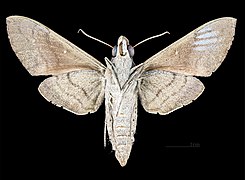Nephele hespera: Difference between revisions
Ruigeroeland (talk | contribs) No edit summary |
added Category:Moths of Malaysia using HotCat |
||
| (40 intermediate revisions by 26 users not shown) | |||
| Line 1: | Line 1: | ||
{{Short description|Species of moth}} |
|||
{{Taxobox |
|||
{{Speciesbox |
|||
| ⚫ | |||
| name = Crepuscular hawkmoth |
|||
| image = Nephele hespera.JPG |
| image = Nephele hespera.JPG |
||
| ⚫ | |||
| image_width = 240px |
|||
| authority = ([[Johan Christian Fabricius|Fabricius]], 1775) |
|||
| regnum = [[Animal]]ia |
|||
| ⚫ | |||
| phylum = [[Arthropod]]a |
|||
*''Sphinx hespera'' <small>Fabricius, 1775</small> |
|||
| class = [[Insect]]a |
|||
*''Sphinx didyma'' <small>Fabricius, 1775</small> |
|||
| ordo = [[Lepidoptera]] |
|||
*''Sphinx quaterna'' <small>Esper, 1794</small> |
|||
| familia = [[Sphingidae]] |
|||
*''Sphinx morpheus'' <small>Cramer, 1777</small> |
|||
| genus = '''''[[Nephele (genus)|Nephele]]''''' |
|||
*''Sphinx chiron'' <small>Cramer, 1777</small> |
|||
| species = '''''N. hespera''''' |
|||
*''Perigonia obliterans'' <small>Walker, 1865</small> |
|||
| binomial = ''Nephele hespera'' |
|||
| binomial_authority = ([[Fabricius]], 1775)<ref>[http://www.cate-sphingidae.org/taxonomy/Nephele/hespera.html CATE Creating a Taxonomic eScience - Sphingidae]</ref> |
|||
| ⚫ | |||
}} |
}} |
||
[[Image:NepheleHespera.png|thumb|200px|left]] |
|||
'''''Nephele hespera''''' is a |
'''''Nephele hespera''''', the '''crepuscular hawkmoth''', is a [[Sphingidae|sphingid]] moth described by [[Johan Christian Fabricius]] in 1775. |
||
== Distribution == |
|||
The larvae feed on ''[[Carissa congesta]]''. |
|||
It is found in the [[tropical]] and [[subtropical]] forests of [[Sri Lanka]], [[India]], [[Nepal]], [[Myanmar]], southern [[China]], [[Thailand]], [[Vietnam]], [[Malaysia]] and [[Indonesia]]. |
|||
== |
== Description == |
||
{{reflist}} |
|||
Head, thorax and abdomen olive brown or green. Abdomen is with lateral black segmental bands. Forewings are olive brown or green, with six faint waved lines and an angled submarginal line. The space between it and outer margin is paler. At the end of the cell, there are two conspicuous silvery-white spots, which may be reduced to a speck or be altogether obsolete. Hindwings are reddish brown and cilia are ochreous. Ventral side is paler, each wing with two transverse lines. Larva is greenish with a pale stripe from 7th to 11th somites.<ref>{{cite book |last=Hampson |first=G. F. |authorlink=George Hampson |url=https://www.biodiversitylibrary.org/item/180068#page/5/mode/1up |title=The Fauna of British India, Including Ceylon and Burma: Moths Volume I |publisher=Taylor and Francis |year=1892 |via=Biodiversity Heritage Library}} {{PD-notice}}</ref> |
|||
==External links == |
|||
<gallery mode="packed"> |
|||
*[http://tpittaway.tripod.com/china/china.htm- Sphingidae of the Eastern Palaearctic] |
|||
Nephele hespera MHNT CUT 2010 0 141 Sumatra male dorsal.jpg|Male dorsal view |
|||
Nephele hespera MHNT CUT 2010 0 141 Sumatra male ventral.jpg|Male ventral view |
|||
Nephele hespera MHNT CUT 2010 0 141 Sumatra female dorsal.jpg|Female dorsal view |
|||
Nephele hespera MHNT CUT 2010 0 141 Sumatra female ventral.jpg|Female ventral view |
|||
</gallery> |
|||
== Biology == |
|||
The larvae feed on ''[[Carissa congesta]]''. Pupa is bone yellow in color. The moth rests with the wings held horizontal and the tip of the abdomen slightly upturned.<ref>{{cite web |last1=Pittaway |first1=A. R. |last2=Kitching |first2=I. J. |date=2018 |url=http://tpittaway.tripod.com/china/n_hes.htm |title=''Nephele hespera'' (Fabricius, 1775) -- Crepuscular hawkmoth |website=Sphingidae of the Eastern Palaearctic |accessdate=December 16, 2018}}</ref> |
|||
==References== |
|||
{{Reflist}} |
|||
{{Taxonbar |from=Q2612315}} |
|||
| ⚫ | |||
| ⚫ | |||
| ⚫ | |||
[[Category:Moths described in 1775]] |
|||
[[Category:Taxa named by Johan Christian Fabricius]] |
|||
[[Category:Moths of Sri Lanka]] |
|||
[[Category:Moths of Indonesia]] |
|||
[[Category:Moths of Malaysia]] |
|||
| ⚫ | |||
Latest revision as of 22:27, 26 February 2024
| Crepuscular hawkmoth | |
|---|---|

| |
| Scientific classification | |
| Domain: | Eukaryota |
| Kingdom: | Animalia |
| Phylum: | Arthropoda |
| Class: | Insecta |
| Order: | Lepidoptera |
| Family: | Sphingidae |
| Genus: | Nephele |
| Species: | N. hespera
|
| Binomial name | |
| Nephele hespera (Fabricius, 1775)
| |
| Synonyms | |
| |
Nephele hespera, the crepuscular hawkmoth, is a sphingid moth described by Johan Christian Fabricius in 1775.
Distribution
[edit]It is found in the tropical and subtropical forests of Sri Lanka, India, Nepal, Myanmar, southern China, Thailand, Vietnam, Malaysia and Indonesia.
Description
[edit]Head, thorax and abdomen olive brown or green. Abdomen is with lateral black segmental bands. Forewings are olive brown or green, with six faint waved lines and an angled submarginal line. The space between it and outer margin is paler. At the end of the cell, there are two conspicuous silvery-white spots, which may be reduced to a speck or be altogether obsolete. Hindwings are reddish brown and cilia are ochreous. Ventral side is paler, each wing with two transverse lines. Larva is greenish with a pale stripe from 7th to 11th somites.[1]
-
Male dorsal view
-
Male ventral view
-
Female dorsal view
-
Female ventral view
Biology
[edit]The larvae feed on Carissa congesta. Pupa is bone yellow in color. The moth rests with the wings held horizontal and the tip of the abdomen slightly upturned.[2]
References
[edit]- ^ Hampson, G. F. (1892). The Fauna of British India, Including Ceylon and Burma: Moths Volume I. Taylor and Francis – via Biodiversity Heritage Library.
 This article incorporates text from this source, which is in the public domain.
This article incorporates text from this source, which is in the public domain.
- ^ Pittaway, A. R.; Kitching, I. J. (2018). "Nephele hespera (Fabricius, 1775) -- Crepuscular hawkmoth". Sphingidae of the Eastern Palaearctic. Retrieved December 16, 2018.




